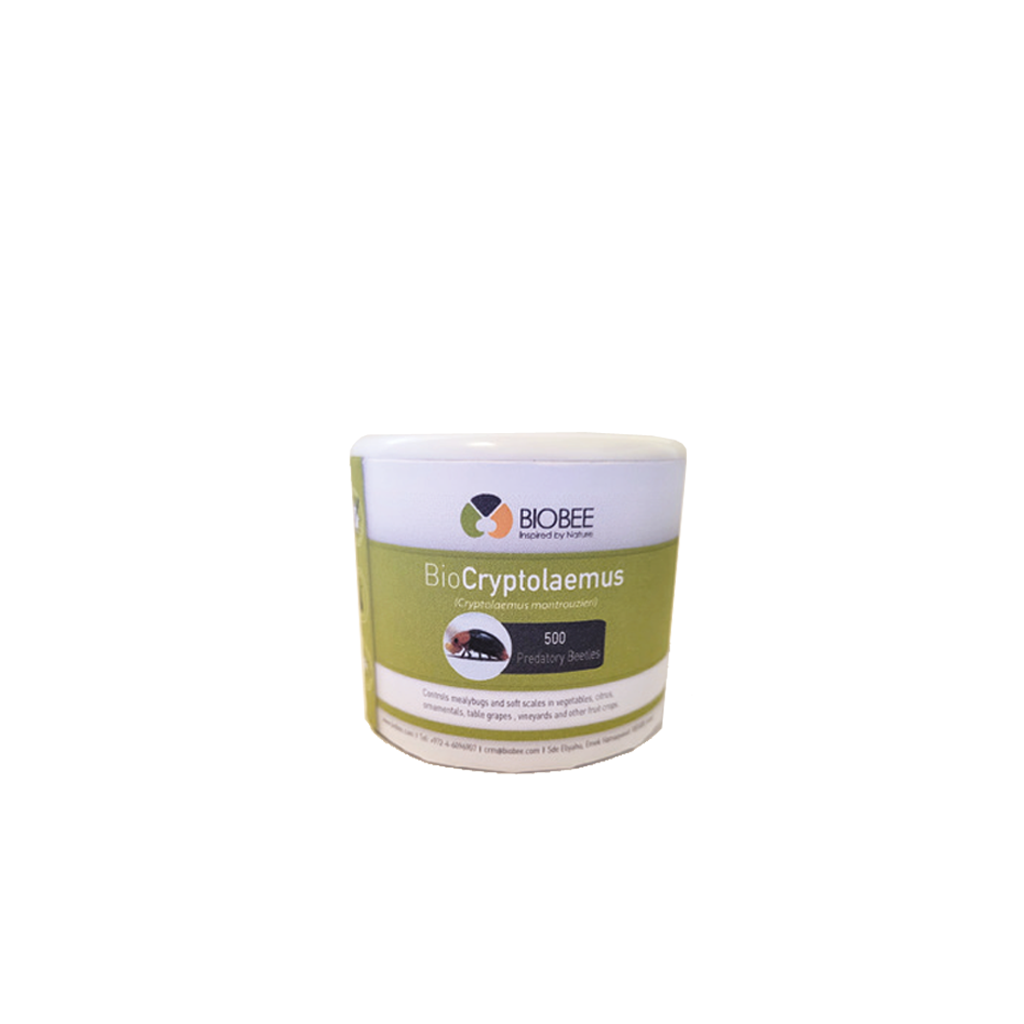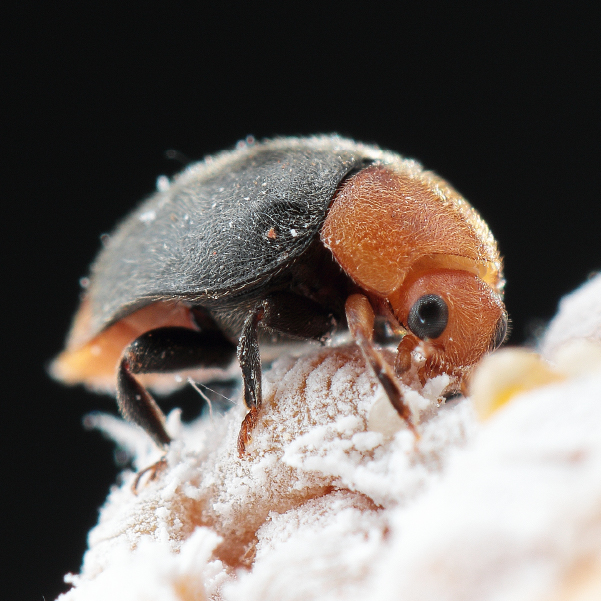BioBee BioCryptolaemus - Cryptolaemus montrouzieri beetle (500 adults / container)
130-110-03-3013
Availability:
backordered
Shipping time if backordered::
jusqu'à 2 semaines
In case of backorder::
Only replenished IF YOU ORDER IT
MAIN TARGETS
Mealybugs
ADDITIONAL TARGETS
Soft scales, aphids, and whiteflies.
TIPS
Cryptolaemus are attracted to and often lay egg on the mealy bugs' waxy secretions and ovisacs (egg masses).
PRODUCT DESCRIPTION & PACKAGING
BioCryptolaemus (Cryptolaemus montrouzieri) is a predatory beetle, also known as the “Mealybug destroyer” because it is a voracious predator of multiple species of mealybugs in both greenhouses and open fields.
C. montrouzieri attacks the citrus mealybug and other closely related mealybug species as well as several soft scales, including hemispherical scale and its relatives. It is considered an important predator of the citrus and long-tailed mealybugs in greenhouses and interior plantscapes and efficiently controls the pink hibiscus mealybug.
This ladybeetle is called the 'mealybug destroyer' because both larvae and adults feed voraciously on mealybug and can consume more than 250 during their lifetime. The highly mobile adults disperse in the crop looking for mealybug hotspots, reducing the need for sprays. Beetles are shipped as adults, ready for release in orchards, vineyards and protected crops.
BioCryptolaemus arrives in a container packed with 500 adults and a honey-soaked paper inside the container, temporarily nourishing them, until their arrival to the final destination.
The product is shipped in cooled, insulated boxes.
STORAGE
- Storage temperature: 12-15°C (53-59°F)
- Apply within 24 hours
- Apply early morning or late afternoon
- Do not store in sunlight
- Treat area against ants
APPLICATION
If ants are present at the mealybug hot spots, the area must be treated against them. Ants encourage honeydew secretion by the mealybugs, transferring them from one place to another while protecting them vigorously from predators.
- Treat the area against ants.
- The predators are released by removing the package’s lid and either placing it adjacent to the mealybug infested spot or, while walking between the plants, tapping the package gently and letting the beetles fly out towards the plants.
- Release beetles in the early morning or late in the afternoon, when temperatures are cooler.
- The beetles should be released within 24 hours of receipt.
- Leave the bottles inside the insulated shipping boxes until placement in the field.
- Remove the containers from the box, one at a time and place them as quickly as possible.
- Do not expose the bottles to direct sunlight.
The amount and frequency of the application (introduction rate) is determined by the target crop, level of infestation, weather conditions and damage inflicted to the crop.
DISCLAMER
Before combining this product with any chemical pesticide in the crop, please consult your BioBee technical field representative.
BioBee Sde Eliyahu Ltd. produces and markets biological products. Production is carried out using innovative techniques under controlled quality assurance standards such as ISO 9001:2015, as well as IOBC’s international standards for mass-production of insects. All products are tested to meet specification requirements before leaving the factory.
The success of biological pest control is affected by the crop’s initial pest population (upon application of the product), weather conditions and chemical residue present in the crop, among other possible aggravating factors.
Under no circumstance shall BioBee or Groupe Horticole Ledoux inc. be liable for the outcome of the implementation in the field, as it has no control over local conditions, the application method, or the possible improper treatment/storage of the product.
Specifications
| Instruction / | delivery |
MAIN TARGETS
Mealybugs
ADDITIONAL TARGETS
Soft scales, aphids, and whiteflies.
TIPS
Cryptolaemus are attracted to and often lay egg on the mealy bugs' waxy secretions and ovisacs (egg masses).
PRODUCT DESCRIPTION & PACKAGING
BioCryptolaemus (Cryptolaemus montrouzieri) is a predatory beetle, also known as the “Mealybug destroyer” because it is a voracious predator of multiple species of mealybugs in both greenhouses and open fields.
C. montrouzieri attacks the citrus mealybug and other closely related mealybug species as well as several soft scales, including hemispherical scale and its relatives. It is considered an important predator of the citrus and long-tailed mealybugs in greenhouses and interior plantscapes and efficiently controls the pink hibiscus mealybug.
This ladybeetle is called the 'mealybug destroyer' because both larvae and adults feed voraciously on mealybug and can consume more than 250 during their lifetime. The highly mobile adults disperse in the crop looking for mealybug hotspots, reducing the need for sprays. Beetles are shipped as adults, ready for release in orchards, vineyards and protected crops.
BioCryptolaemus arrives in a container packed with 500 adults and a honey-soaked paper inside the container, temporarily nourishing them, until their arrival to the final destination.
The product is shipped in cooled, insulated boxes.
STORAGE
- Storage temperature: 12-15°C (53-59°F)
- Apply within 24 hours
- Apply early morning or late afternoon
- Do not store in sunlight
- Treat area against ants
APPLICATION
If ants are present at the mealybug hot spots, the area must be treated against them. Ants encourage honeydew secretion by the mealybugs, transferring them from one place to another while protecting them vigorously from predators.
- Treat the area against ants.
- The predators are released by removing the package’s lid and either placing it adjacent to the mealybug infested spot or, while walking between the plants, tapping the package gently and letting the beetles fly out towards the plants.
- Release beetles in the early morning or late in the afternoon, when temperatures are cooler.
- The beetles should be released within 24 hours of receipt.
- Leave the bottles inside the insulated shipping boxes until placement in the field.
- Remove the containers from the box, one at a time and place them as quickly as possible.
- Do not expose the bottles to direct sunlight.
The amount and frequency of the application (introduction rate) is determined by the target crop, level of infestation, weather conditions and damage inflicted to the crop.
DISCLAMER
Before combining this product with any chemical pesticide in the crop, please consult your BioBee technical field representative.
BioBee Sde Eliyahu Ltd. produces and markets biological products. Production is carried out using innovative techniques under controlled quality assurance standards such as ISO 9001:2015, as well as IOBC’s international standards for mass-production of insects. All products are tested to meet specification requirements before leaving the factory.
The success of biological pest control is affected by the crop’s initial pest population (upon application of the product), weather conditions and chemical residue present in the crop, among other possible aggravating factors.
Under no circumstance shall BioBee or Groupe Horticole Ledoux inc. be liable for the outcome of the implementation in the field, as it has no control over local conditions, the application method, or the possible improper treatment/storage of the product.
| Order-driven inventory |























